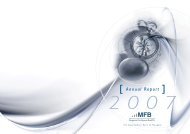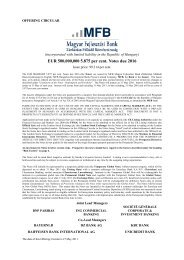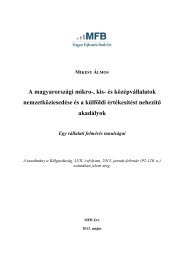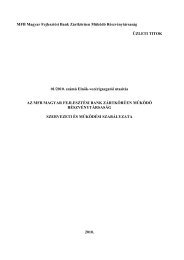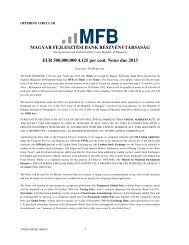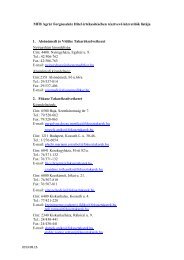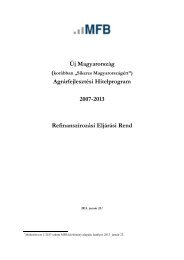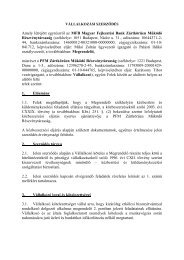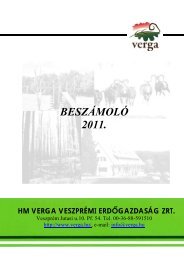ANNUAL REPORT 2011 - Magyar Fejlesztési Bank Zrt.
ANNUAL REPORT 2011 - Magyar Fejlesztési Bank Zrt.
ANNUAL REPORT 2011 - Magyar Fejlesztési Bank Zrt.
You also want an ePaper? Increase the reach of your titles
YUMPU automatically turns print PDFs into web optimized ePapers that Google loves.
THE OPERATING ENVIRONMENT<br />
OF MFB HUNGARIAN DEVELOPMENT BANK<br />
PRIVATE LIMITED COMPANY IN <strong>2011</strong><br />
Recovery from the global economic crisis halted after a<br />
promising start in early <strong>2011</strong>. Employment and government<br />
indebtedness lurked at stubbornly high levels in the second<br />
half of the year. Additional rounds of monetary stimulus<br />
raised queries and the banking system was marred<br />
with lack of confidence. The outlook of the Eurozone,<br />
which carries fairly high priority for the Hungarian<br />
economy, worsened considerably with diverging<br />
processes questioning the foundations of integration with<br />
much greater vehemence than ever before.<br />
The internal drivers of growth failed to start in the Hungarian<br />
economy in <strong>2011</strong>. Corporations tended to move into something<br />
like “hibernation” or operating in restraint mode, which could<br />
become an impediment to sustained growth and also reduced<br />
the predictability of debt management. The extreme volatility of<br />
exchange rate movements, the overall weakening of the national<br />
currency and the steady rise of the country’s risk premium spelt<br />
hardships for external funding for both the Hungarian economy<br />
and MFB.<br />
Global economic processes<br />
Providing the broader backdrop to the operations of MFB Hungarian<br />
Development <strong>Bank</strong>, the global economy took a promising start<br />
in <strong>2011</strong> as recovery from the crisis accelerated transitionally<br />
during Q1. However, maintaining the rate of growth failed and Q1<br />
performance was fundamentally driven by unique factors. Starting<br />
the second quarter of <strong>2011</strong>, the rate of economic growth faltered<br />
visibly both in developed and emerging regions and helped the<br />
annual growth of international trade subside to a single digit.<br />
Beside the sovereign crisis, the economic consequences of the<br />
political havoc engulfing Northern Africa and the Arab Peninsula<br />
coupled with Japan’s nuclear disaster to contribute to the<br />
slowdown of global growth.<br />
<br />
<br />
<br />
<br />
<br />
<br />
<br />
<br />
<br />
<br />
<br />
SOURCES: EUROStat, NatiONal BUREaU Of StatiStiCS Of ChiNa<br />
After mid-<strong>2011</strong>, global economic processes sent repeated<br />
crisis signals as growth subsided noticeably with the most of the<br />
ills focused in the old continent (and especially the Euro Area):<br />
by the end of the year most indices of economic sentiment were<br />
approximating levels seen during the crisis two years ago, revealing<br />
the bare real economic impact of the sovereign crisis hitting<br />
the member states. In the early part of <strong>2011</strong>, growth of Europe’s<br />
single currency economies was driven by capital expenditure and<br />
construction projects delayed from late 2010 due to bad weather<br />
and by making up for lost production, but the upswing of Q1 (2.4%<br />
yoy) was followed by gradual deceleration (Q2: 1.6%, Q3: 1.3%,<br />
MFB <strong>ANNUAL</strong> <strong>REPORT</strong> <strong>2011</strong><br />
5



